Shrimp pesto pasta is actually one of the fastest gourmet meals you can prepare, taking just 20 minutes from start to finish. As a chef, I’ve found this recipe to be consistently reliable, specifically because it combines convenience with restaurant-quality results.
What makes this dish particularly special is its impressive value – at just $2.02 per serving, you’re getting a protein-rich meal that packs 23g of protein and serves 4-6 people. Moreover, since it’s a one-pot recipe, you won’t spend your evening cleaning up multiple dishes.
In this guide, I’ll share my professional secrets for selecting the perfect shrimp, mastering the pasta water technique, and creating the ideal pesto balance. These are the exact methods I’ve developed through years of restaurant experience to ensure this dish never fails.
The Secret Behind Perfect Shrimp Selection
Selecting the right shrimp is the foundation of a memorable shrimp pesto pasta. My years behind the stove have taught me that this initial choice dramatically influences the final dish’s texture, appearance, and overall enjoyment.
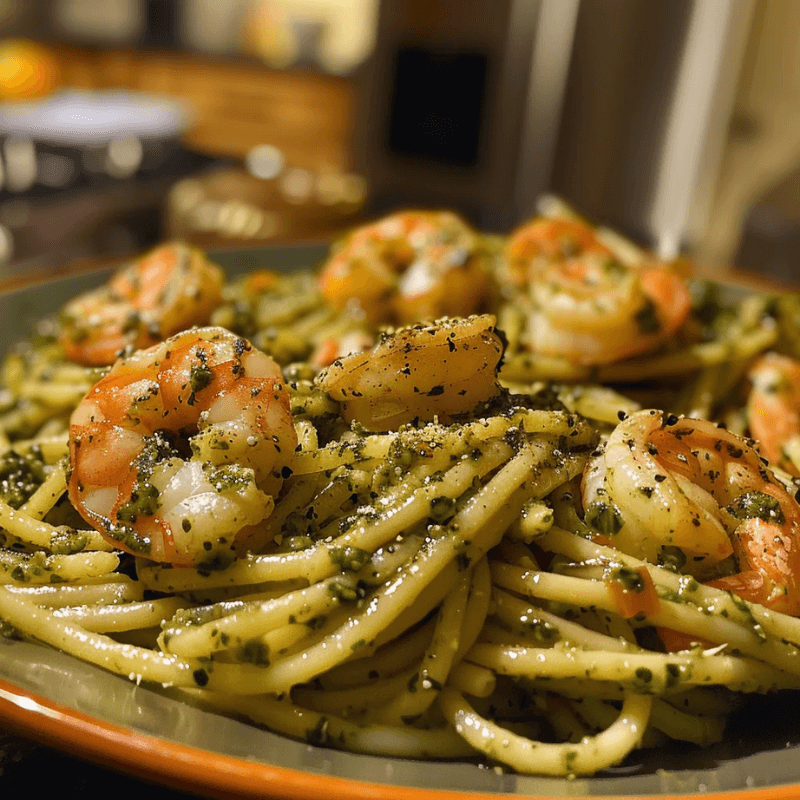
Easy & Flavorful Shrimp Pesto Pasta – Ready in 20 Minutes!
Why size matters for shrimp pesto pasta
When shopping for shrimp, you’ll notice mysterious numbers like “16/20” or “U10” on packaging. These numbers actually indicate how many shrimp make up one pound. The smaller the number, the bigger the shrimp. This sizing system is far more reliable than subjective labels like “jumbo” or “medium” which vary between sellers.
For shrimp pesto pasta specifically, medium to large shrimp create the ideal balance. Southern Living recommends this size range because it yields approximately 35-41 shrimp per pound. There’s solid reasoning behind this recommendation:
- Medium to large shrimp are substantial enough to be easily captured with a fork
- They don’t get lost among the pasta strands
- They cook quickly (about five minutes) yet maintain their texture
While jumbo shrimp might seem impressive, they can overwhelm the delicate flavors of pesto. Alternatively, many home cooks find that larger shrimp provide a satisfying visual appeal – creating the impression of a more substantial dish even though the weight remains identical.
Fresh vs. frozen: what chefs actually prefer
Despite what you might assume, most professional chefs actually prefer frozen shrimp over “fresh” options at the seafood counter. This seemingly counterintuitive preference stems from a simple industry reality: nearly all shrimp are flash-frozen immediately after harvesting.
Those tempting “fresh” displays at your supermarket? They’re typically just thawed frozen shrimp that continue losing freshness with each passing hour. In contrast, properly frozen shrimp remain suspended in time at peak freshness until you’re ready to use them.
When selecting frozen shrimp:
- Avoid packages with visible ice crystals (indicates thawing and refreezing)
- Look for shrimp with firm, attached shells without black spots
- Reject any packages emitting an ammonia smell – this signals spoilage
Properly thawing frozen shrimp is equally important. Place them under cold (never warm) running water for a few minutes or in a bowl of cold water. Furthermore, after thawing, always pat the shrimp completely dry before cooking to ensure proper searing.
How to tell when shrimp is perfectly cooked
Overcooking shrimp is remarkably easy yet drastically compromises your pasta dish. Properly cooked shrimp should be pinkish on the outside and white/opaque in the center. However, color alone isn’t the most reliable indicator.
The definitive test lies in watching the shrimp’s shape during cooking. As America’s Test Kitchen notes, perfectly cooked shrimp form a “C” shape, while overcooked shrimp curl into a tight “O” shape. This happens because the protein strands tighten as they cook.
Timing is perhaps the most critical element – shrimp typically require just 2-4 minutes of cooking. I find the ideal approach is to cook until they’ve just turned pink and opaque, then immediately remove them from heat. Remember that residual heat continues cooking them even after removal from the pan.
For shrimp pesto pasta specifically, this precise timing creates that restaurant-quality texture – tender yet firm with a pleasant snap when bitten. Additionally, some chefs recommend notching shrimp after deveining to prevent extreme curling during cooking.
By mastering these three aspects of shrimp selection and preparation, you’ve already eliminated the most common pitfalls that separate mediocre shrimp pasta from exceptional versions. In essence, your careful attention at this initial stage sets the foundation for the entire dish’s success.
Mastering the Pasta Water Technique
The unsung hero of exceptional shrimp pesto pasta isn’t found in fancy ingredients or complicated techniques—it’s the humble pasta water most home cooks pour down the drain. This cloudy liquid is what professional chefs consider “liquid gold,” transforming good pasta into restaurant-quality dishes.
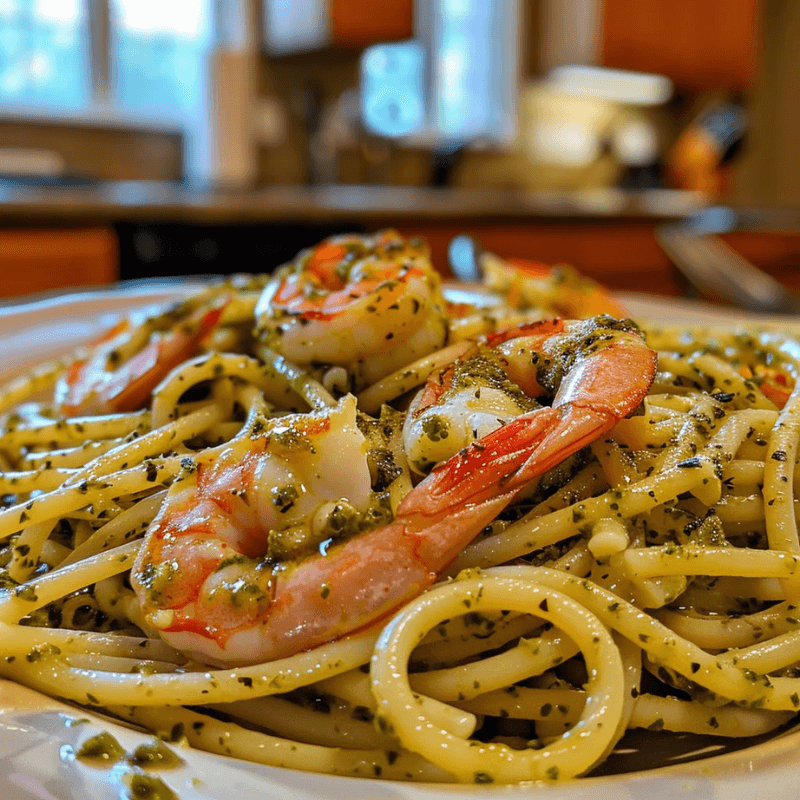
Creamy Shrimp Pesto Pasta – A Perfect Weeknight Dinner!
The science of starchy pasta water
Behind that murky appearance lies powerful culinary science. As pasta cooks, it releases starch into the water, creating a natural thickening agent. The starchiness directly correlates with your water-to-pasta ratio—cooking a pound of pasta in a half-gallon of water yields considerably starchier water than using a full gallon.
Most importantly, pasta water isn’t just water with starch—it’s essentially the same ingredients as a cornstarch slurry. This starchy liquid acts as an emulsifier, physically preventing tiny fat molecules from coalescing. Think of pasta water as the diplomatic mediator between your sauce and noodles, helping them bond together.
To maximize starchiness, some chefs use just enough water to barely cover the pasta. Alton Brown even recommends starting pasta in cold water, which not only saves energy but creates more concentrated starchy water. The difference is visible—properly starchy water appears noticeably cloudier and will transform your shrimp pesto pasta from ordinary to extraordinary.
Exactly how much water to reserve
Prior to draining pasta, I always reserve some of this precious cooking liquid. But precisely how much? For most home cooks making shrimp pesto pasta, a good rule is starting with ¼ cup of pasta water for every serving of sauce. Yet, for a pound of pasta serving 5 people, you might need between ½ cup to 1 cup total.
To avoid coming up short, catch 1-2 cups before draining. With pesto specifically, adding ¼ to ½ cup of pasta water helps the pesto coat your noodles properly. As you combine ingredients, you may need additional water—up to about 2 cups per pound of pasta—to achieve the perfect consistency.
How pasta water creates the perfect sauce consistency
The magic happens when combining pasta water with your shrimp and pesto. The starchy liquid performs several crucial functions simultaneously:
- It binds ingredients together, helping sauce adhere to every strand of pasta
- It emulsifies fats from cheese, olive oil, and pesto into a silky-smooth sauce
- It thickens the sauce without making it heavy or gummy
Once everything is in the pan—pasta, sauce, pasta water—gentle simmering is key. The hotter your pan, the more vigorously the sauce bubbles, creating a better emulsion. I typically stir and toss continuously over medium-high heat until the sauce reaches that perfectly silky, glossy texture.
The proof is in the appearance: a properly finished shrimp pesto pasta has a saucy but not watery consistency, with the sauce clinging to each piece of pasta rather than pooling at the bottom of the plate. Without this technique, even the finest pesto or perfectly cooked shrimp would result in a dish that’s merely acceptable instead of exceptional.
Just note that pasta water contains salt, consequently there’s risk of oversalting if you keep adding and reducing large amounts. Nevertheless, this technique remains the definitive difference between amateur and professional-quality shrimp pesto pasta.
The Three-Step Pesto Method No One Tells You
Pesto forms the vibrant soul of shrimp pesto pasta, yet many home cooks struggle to achieve that perfect restaurant-quality sauce. After preparing thousands of pasta dishes professionally, I’ve discovered a three-step method that guarantees consistent results every time.
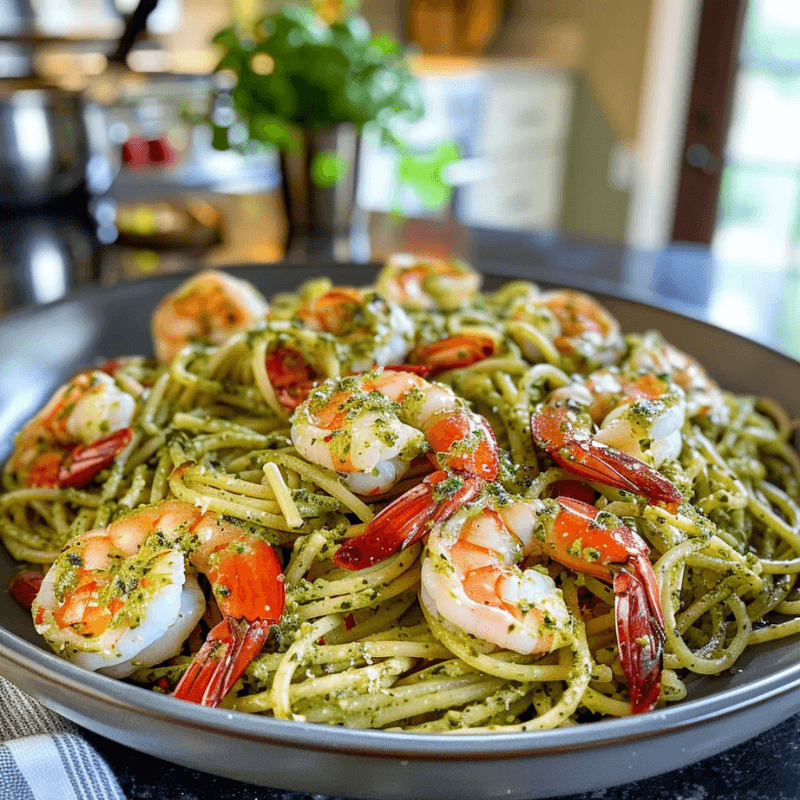
Garlic Butter Shrimp Pesto Pasta – Bursting with Flavor!
Store-bought vs. homemade: when to use each
Contrary to popular belief, store-bought pesto isn’t always inferior to homemade. In fact, when comparing professional taste tests, restaurant-quality prepared pesto occasionally outperforms homemade versions. The deciding factors typically come down to three considerations:
Cost: Homemade pesto using premium ingredients (pine nuts, extra virgin olive oil) costs significantly more than store-bought options. This happens because commercial producers often use less expensive substitutes like canola oil, soybean oil, or walnuts instead of traditional ingredients.
Time investment: Making pesto from scratch takes about 10 minutes, whereas opening a jar takes seconds. For weeknight shrimp pesto pasta, high-quality jarred pesto delivers excellent results with minimal effort.
Flavor profile: For special occasions, I recommend homemade pesto. Look for refrigerated options in the deli section when buying prepared pesto, as they generally contain better ingredients than shelf-stable varieties found in the pasta aisle.
The temperature trick that preserves pesto’s color
The most frustrating aspect of pesto is watching its vibrant green color transform into an unappealing army green. Accordingly, professional chefs employ a temperature trick that few home cooks know about.
Paolo Laboa, winner of the 2008 Pesto World Championship, revealed that chilling your equipment before making pesto significantly slows oxidation. Here’s how to implement this technique:
- Place your food processor bowl and blade in the refrigerator overnight
- Alternatively, fill the bowl with ice water while prepping ingredients
- If using a mortar and pestle, choose marble specifically because it maintains cooler temperatures
This technique works remarkably well – tests show chilled equipment preserves the bright green color substantially longer than room-temperature tools.
Balancing pesto flavors like a professional
The three-step pesto method that produces perfectly balanced flavor centers around proper ingredient integration:
Step 1: Gradual incorporation Begin with garlic and pine nuts, thoroughly crushing them before adding basil. This releases essential oils and creates a foundation for the sauce.
Step 2: Temperature control Besides chilling equipment, avoid excessive heat from food processor blades by using short pulses rather than continuous processing. Some chefs even freeze their removable blades for an hour before making pesto.
Step 3: Manual finish For optimal texture, stir in Parmesan cheese by hand just before serving rather than blending it in. This preserves the cheese’s texture and prevents over-processing.
To maintain balance, consider adding fresh lemon juice – it brightens flavor while simultaneously enhancing color. Furthermore, for longer storage, drizzle a thin layer of olive oil over the surface of your pesto to prevent oxidation, or freeze it in small portions for up to three months.
Timing Secrets That Prevent Overcooked Shrimp
The seconds between perfectly cooked shrimp and rubbery disappointment are surprisingly few. As a professional chef, I’ve witnessed countless plates of shrimp pesto pasta ruined in the final moments of preparation—often by cooks who excel at every other aspect of the dish.
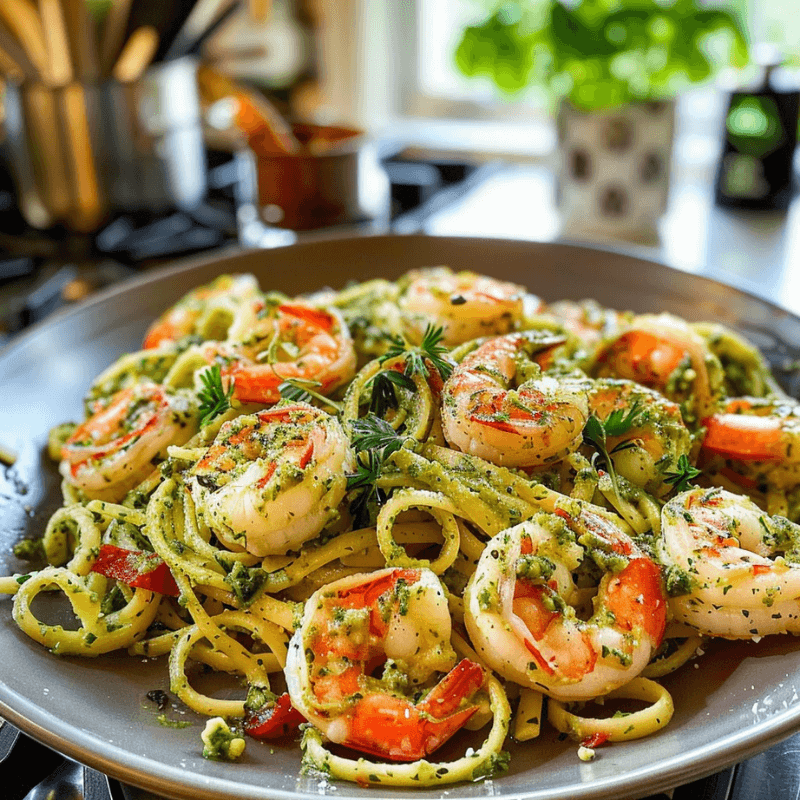
Why most home cooks ruin their shrimp
Unfortunately, overcooking is the single most common mistake when preparing shrimp pesto pasta. The culprit? A fundamental misunderstanding of shrimp’s lightning-fast cooking process. Unlike beef or chicken that forgive a minute or two of extra heat, shrimp can go from raw to tough and dry in mere moments.
Firstly, many home cooks feel compelled to “cook shrimp through completely” out of food safety concerns, inadvertently pushing them far past their optimal texture point. In reality, properly cooked shrimp need minimal cooking time—typically just 2-3 minutes total for medium-sized shrimp.
Another common error involves cooking shrimp directly in the sauce. Although this seems logical, it often results in rubbery outcomes as the shrimp continue cooking in the residual heat long after they should have been removed.
The 30-second rule for perfect texture
Professional chefs rely on a simple yet effective 30-second rule when cooking shrimp. This involves watching for dramatic visual transformations that occur rapidly:
- Color change: From translucent bluish-gray to opaque pink and white
- Shape formation: Properly cooked shrimp form a relaxed “C” shape
- Internal temperature: Perfectly done at just 120°F, far lower than other proteins
Above all, remember that overcooked shrimp curl into tight “O” shapes—a telltale sign you’ve gone too far. For medium shrimp, the entire cooking process takes approximately 3 minutes; large shrimp need 4-5 minutes; jumbo require 6-7 minutes.
How to coordinate pasta and shrimp cooking times
The secret to restaurant-quality shrimp pesto pasta lies in a two-stage cooking approach. Begin by boiling water for pasta first, then start preparing the shrimp while the pasta cooks.
Alternatively, use this chef-approved method: quickly sear the shrimp over high heat to build flavor, promptly remove them from the pan, then finish building your sauce and cooking pasta before reintroducing the shrimp at the very end. This technique guarantees they won’t overcook while you complete the other components.
For optimal results, remove pasta from boiling water 1-2 minutes before the package’s recommended al dente time. This slight undercooking allows the pasta to finish perfectly when tossed with the sauce and shrimp.

Welcome to HealthyBlog365, your go-to destination for all things food and drink. We believe that every meal is not just a way to nourish your body but also a meaningful connection with yourself and your loved ones.
HealthyBlog365 was created with a mission to inspire healthy living through nutritious meals and refreshing beverages. Here, you’ll discover a treasure trove of creative recipes, kitchen tips, and healthy eating trends tailored to fit modern lifestyles.
 What can you find on HealthyBlog365?
What can you find on HealthyBlog365?
- Delicious and easy-to-make recipes: From simple meals for busy mornings to wholesome dinners for family gatherings, we’ve got you covered for every occasion.
- Nutritious drinks: Explore recipes for juices, smoothies, detox teas, and drinks that cleanse your body, boost your mood, and energize your day.
- Guides on eating habits: Get detailed insights into popular diets like keto, low-carb, and vegetarian-friendly meal plans.
- Kitchen hacks: Discover smart tips to save time, preserve food, and cook more efficiently.
We are committed to providing high-quality content, staying up-to-date with the latest trends, and maintaining a balance between nutrition and flavor.
 Connect with HealthyBlog365 on Social Media
Connect with HealthyBlog365 on Social Media
Join the HealthyBlog365 community on social media platforms to stay updated with our latest posts, watch exciting tutorials, and share your food stories with us:
Facebook: Follow us here to stay updated with our latest posts and join our community.
Instagram: Check us out here for inspiring visuals and ideas.
Pinterest: Pin with us here to save creative ideas you’ll love.
YouTube: Subscribe here for detailed tutorials and exciting videos.
 Thank You for Supporting HealthyBlog365!
Thank You for Supporting HealthyBlog365!
We aim to build a connected community where everyone can share and learn from each other. If you have any questions or suggestions, don’t hesitate to reach out to us via social media or our website.
We hope you have a wonderful time on HealthyBlog365 and find new inspiration for your healthy culinary journey!
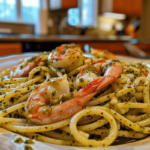
Shrimp Pesto Pasta
Description
Ingredients
- 8 oz linguine or spaghetti
- 1 lb fresh shrimp peeled and deveined
- 1 cup fresh basil pesto
- 1 cup cherry tomatoes halved
- ½ cup grated Parmesan cheese
- 2 cloves garlic minced
- 2 tbsp extra virgin olive oil
- Salt and pepper to taste
Instructions
- Prepare all ingredients: chop garlic and halve cherry tomatoes.
- Cook the pasta according to package instructions in salted boiling water until al dente. Drain and set aside, reserving some pasta water.
- In a skillet over medium heat, warm olive oil and sauté minced garlic until fragrant. Add shrimp; cook until pink and opaque.
- Stir in halved cherry tomatoes; cook for another 2 minutes before adding pesto sauce.
- Gently fold cooked pasta into the skillet with the shrimp mixture. Adjust consistency with reserved pasta water if needed.
- Serve garnished with grated Parmesan cheese and freshly cracked pepper.
